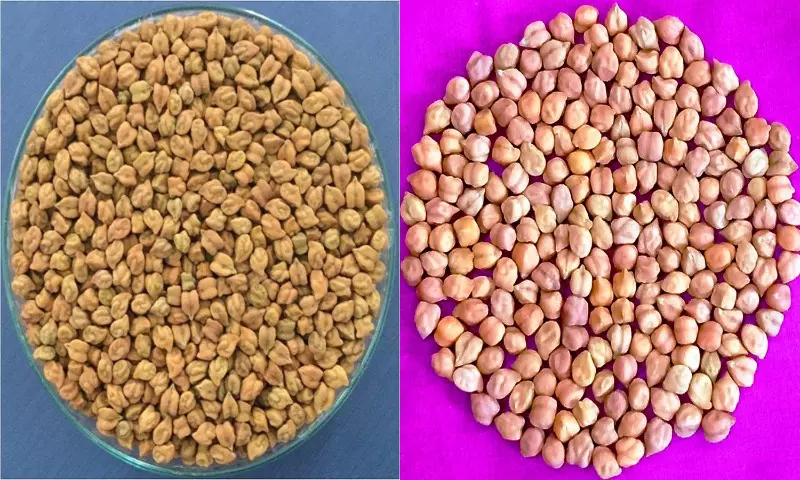New climate-resilient, disease-resistant chickpea varieties coming farmers' way: ICRISAT study
Among the three new chickpea varieties are the two drought-tolerant varieties – IPC L4-14 and BGM 4005 – that were developed by transferring "QTL-hotspot" (genes for drought tolerance) from the donor chickpea variety ICC 4958 into two leading parental chickpea varieties, DCP 92-3 and Pusa 362, respectively.
By Newsmeter Network
Hyderabad: Three new chickpea varieties with enhanced drought tolerance, disease resistance, and high yield are set to become available to Indian farmers soon.
The new chickpea varieties - IPC L4-14, BGM 4005, and IPCMB 19-3 - are a result of ICRISAT's collaborations with ICAR-Indian Institute of Pulses Research (IIPR) in Kanpur and ICAR-Indian Agricultural Research Institute (IARI), New Delhi. BGM 4005 and IPCMB 19-3 were among the crop varieties dedicated to India by Prime Minister Narendra Modi on 28 September.
Dr. Trilochan Mohapatra, the director-general of ICAR, said genomics-driven interventions to enhance crop yield and tolerance to biotic and abiotic stresses are the need of the hour under changing climate. "The national agricultural research system led by ICAR has been working in this direction to develop high yielding and climate-resilient crop varieties. Thirty-five varieties of different crops with special traits, including climate resilience, were dedicated to India by the Prime Minister. Two of these were chickpea developed in partnership with ICRISAT," added Dr. Mohapatra.
Why chickpea improvement?
Dr. Arvind Kumar, ICRISAT's deputy director-general (research), pointed the threat of drought in chickpea-growing regions of India while explaining the need for sustained and continued research to improve the crop. "Drought alone causes up to 60% annual yield losses in chickpea. Changing climate warrants development of cultivars that can attain their maximum potential under drought stress in rain-fed environments as well as in disease prone-environments," he said.
Among the three new chickpea varieties are the two drought-tolerant varieties – IPC L4-14 and BGM 4005 – that were developed by transferring "QTL-hotspot" (genes for drought tolerance) from the donor chickpea variety ICC 4958 into two leading parental chickpea varieties, DCP 92-3 and Pusa 362, respectively.
After evaluation at several locations under no-irrigation (rain-fed conditions) for many years, the new varieties reported 14.76% and 11.9% overall mean yield advantage over their parental lines. These varieties have been released for cultivation in the northwest plain zone covering Punjab, Haryana, planes of Jammu and Kashmir, parts of Rajasthan, and western Uttar Pradesh.
The third variety is Fusarium wilt-resistant IPCMB 19-3 which is also called Samriddhi. Developed by transferring Foc2 race resistance genes into the parent variety Pusa 256, this variety showed an overall mean yield advantage of 30.3% over its parent line. IPCMB 19-3 has been released in the central zone covering Madhya Pradesh, Maharashtra, Gujarat, and the Bundelkhand region of Uttar Pradesh.
Dr. N.P Singh, the director of ICAR- IIPR, while emphasizing the role of genomics-assisted breeding, said such high-yielding varieties developed through new approaches will enhance chickpea production further in India.
Calling for the deployment of "fast-forward breeding", a newly conceived framework that promises faster delivery of varieties to farmers, Dr. Rajeev Varshney, research program director (accelerated crop improvement) at ICRISAT, said, "Counting three other varieties released in 2019 and 2020, genomics-assisted breeding has delivered six high-yielding chickpea varieties in India during the last three years."